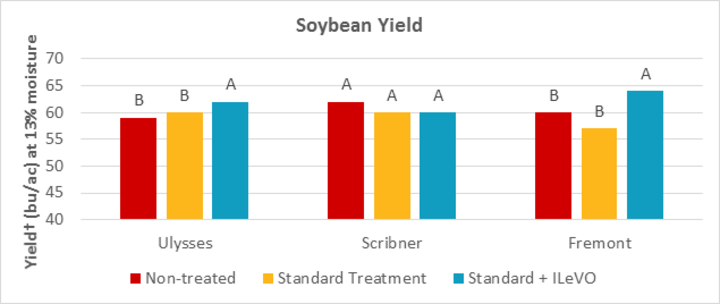As Nebraska farmers prepare for soybean planting, they have a new option for controlling sudden death syndrome (SDS).
The disease is caused by the soil borne fungus Fusarium virguliforme. Sudden death syndrome was first observed in Nebraska in 2004 in Nemaha and Pierce counties in eastern Nebraska. While this is a relatively new disease for Nebraska soybean farmers, there are several locations in the state where significant percentages of fields have been affected.
The disease is favored in high-yield environments and is more prevalent during cool, wet growing seasons. Fields that have soybean cyst nematode (SCN) have a greater likelihood of having more severe SDS. Additional information on SDS is available in the Crop Disease Management section at cropwatch.unl.edu/sudden-death-syndrome.
Seed treatments have not been effective in controlling SDS, limiting the options for farmers managing this disease. Soybean growers were encouraged to adjust their management by selecting varieties with moderate-to-high levels of resistance to SDS and avoid early planting in fields known to be severely affected by SDS. However, previous research has shown that for each day planting is delayed after May 1, 0.25 to 0.625 bu/ac of yield can be lost, making delayed planting a less than optimal management practice.
Evaluating ILeVO®
In 2015, three farmers working with the Nebraska On-Farm Research Network evaluated ILeVO®, a Bayer Crop Science seed treatment. While this product has shown promise for addressing SDS, there are no clear guidelines to determine at what point a field will see enough response to ILeVO® to justify treatment.
The objectives of this study were
- to evaluate if the seed treatment ILeVO® provided additional benefit beyond that currently provided by variety selection and
- to determine if ILeVO® provided adequate control of SDS in early planted soybeans.
Soybean varieties with good resistance to SDS were selected for this study. The impact of variety selection can be seen in Figure 2. Varieties used in this study were comparable to the more resistant variety shown on the right in Figure 2.
The farmers in this study were also encouraged to not delay planting if possible; however, wet weather proved challenging. The study sites were sampled for SCN to establish the base infestation level for the trial. Site information is shown in Table 1.
Nebraska On-Farm Research Network:
Volunteers Sought for 2016 ILeVO® Study
The Nebraska On-Farm Research Network will be continuing this project in 2016. We are currently looking for three locations with a history of sudden death syndrome on soybeans. If you are interested in participating, please contact Laura Thompson at laura.thompson@unl.edu or 402-472-8043.


| Site | Soil Texture | Average SCN Population (# of eggs/100 cc soil) | Variety | Planting Date | Harvest Date |
|---|---|---|---|---|---|
| Fremont | Silty clay loam | 1,117 (medium) | Asgrow 2834 | 5/21/15 | 10/6/15 |
| Scribner | Silty clay loam | 33 (low) | Hoegemeyer 2860 NRR | 5/21/15 | 10/6/15 |
| Ulysses | Silt loam | 247 (low) | Asgrow 2733 | 5/29/15 | 10/2/15 |
Three treatments were evaluated at sites that had SDS the last year when soybeans were grown (2013):
- non-treated soybean seed,
- standard soybean seed treatment (at the Ulysses site the standard seed treatment was Eclipse; at the Fremont and Scribner sites, the standard seed treatment was Acceleron fungicide with Poncho/VOTiVO), and
- standard soybean seed treatment plus ILeVO® at the high rate for SDS (0.18 fl oz/140,000 seed unit).


Foliar disease symptoms were assessed using an SDS scoring method developed by Southern Illinois University at Carbondale. The disease severity was assessed using a 1 to 9 scoring system with a score of 1 indicating the fewest symptoms and 9 indicating premature death. Disease incidence of affected plants was determined by observing the percentage of plants with leaf symptoms. These metrics were combined to create the disease index (DX). Foliar symptoms were assessed twice in the growing season. Disease index shown below (Figure 3) is for the second and final assessment at each field taken on September 1 and 2, 2015. The Scribner site had very low disease index and no difference between the three seed treatments, while the other two sites had a lower disease index for the ILeVO® treatment.
Yields at harvest were recorded (Figure 4) using a weigh wagon. There was a significant yield increase for the ILeVO® treatment as compared to the standard seed treatment at the Ulysses and Fremont sites. (Ulysses had a 2 bu/ac yield increase; Fremont had a 7 bu/ac yield increase.) The Scribner site, which had a very low disease index and low SCN numbers, did not see a yield response for the ILeVO® treatment. Because SDS occurs in pockets throughout a field it is difficult to establish a disease threshold of when to use ILeVO® in order to justify added costs.
The Nebraska On-Farm Research Network is a collaborative partnership of Nebraska Extension, the Nebraska Corn Board, Nebraska Corn Growers Association, Nebraska Soybean Board, and the Nebraska Dry Bean Commission. The goal of the network is to provide a statewide on-farm research program addressing critical farmer production, profitability, and sustainability questions. For more information on the Nebraska On-Farm Research Network visit cropwatch.unl.edu/farmresearch.
